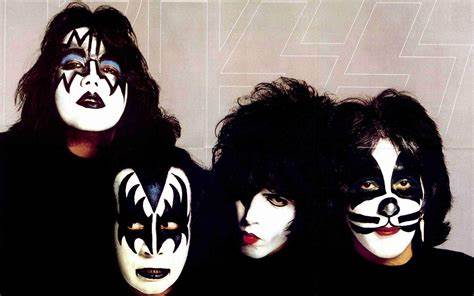In the glittering annals of rock and roll history, few bands have captured the imagination of audiences quite like KISS. Renowned not only for their explosive performances and ear-shattering music but also for their iconic makeup, KISS became a cultural phenomenon that transcended the boundaries of music. The band’s members, Gene Simmons, Paul Stanley, Ace Frehley, and Peter Criss, adorned themselves with intricate face paint that became their trademark. Behind the greasepaint and glam, however, lies a fascinating story of inspiration, creativity, and a touch of theatrical magic.
The Birth of KISS: A Rock Revolution
Formed in 1973 in New York City, KISS emerged at a time when the music scene was undergoing a radical transformation. The glam rock movement was in full swing, characterized by flamboyant costumes, androgynous aesthetics, and elaborate stage shows. KISS, however, took this trend a step further by embracing an alter-ego persona, complete with face paint that turned them into larger-than-life characters. The question on everyone’s lips, then, is where did this inspiration for their makeup come from?
A Canvas of Influences: From Kabuki to Comics
KISS’s makeup was a product of diverse influences, amalgamating elements from various cultural and artistic sources. One of the primary inspirations behind their makeup was the ancient Japanese art form of Kabuki theater. Kabuki actors used vibrant colors and bold designs to depict different characters and emotions, a tradition that dates back centuries. KISS borrowed this concept, transforming themselves into the Kabuki-inspired rock gods that fans came to adore.
Moreover, comic books played a pivotal role in shaping the band’s visual identity. With their larger-than-life superheroes and supervillains, comics offered a rich tapestry of characters that fascinated the band members. Gene Simmons once stated that comic books helped him understand the power of creating a memorable visual image, influencing the band’s decision to adopt makeup personas. The Demon, The Starchild, The Spaceman, and The Catman were born from the pages of comic books and translated onto the faces of KISS.
The Glam and the Glitter: Glam Rock’s Influence
Glam rock, with its extravagant costumes and flamboyant makeup, was another significant influence on KISS’s iconic look. Artists like David Bowie, T. Rex, and New York Dolls blurred the lines between masculinity and femininity, embracing androgyny in their appearance. KISS took this gender-bending trend and transformed it into a theatrical spectacle, pushing the boundaries of what was acceptable in mainstream music.
The Evolution of Individuality: Unique Identities within KISS
While the overall theme of makeup was unified in its theatricality, each member of KISS injected their personality into their respective characters. Gene Simmons’ Demon persona exuded menace and power, mirroring his onstage presence. Paul Stanley’s Starchild, on the other hand, embodied charisma and charm, a reflection of Stanley’s natural stage allure. Ace Frehley’s Spaceman was an embodiment of otherworldly mystique, while Peter Criss’s Catman exuded a primal, animalistic energy.
The Legacy of the KISS Army: Impact on Pop Culture
The impact of KISS’s makeup transcended their music, seeping into the fabric of pop culture. Countless bands and artists, both within and outside the rock genre, have cited KISS as a major influence. Moreover, their unique approach to self-presentation paved the way for a new era of theatricality in music, inspiring subsequent generations of performers to embrace the power of visual storytelling.
KISS’s makeup became an enduring symbol, representing the freedom of expression and the art of transformation. It was not just a mask but a statement, a way for the band to connect with their audience on a deeper level. The KISS Army, the band’s dedicated fan base, embraced this ethos, often donning their own versions of the iconic makeup at concerts and events, solidifying the band’s influence on popular culture.
Conclusion: Unmasking the Inspiration
In the grand tapestry of music history, KISS stands as a testament to the fusion of creativity, culture, and identity. Their makeup, inspired by Kabuki theater, comic books, and the glam rock movement, became a symbol of self-expression, breaking barriers and redefining the parameters of rock and roll theatrics. KISS not only created timeless music but also a visual spectacle that continues to captivate audiences around the world.
As we peel away the layers of greasepaint and glitter, we uncover a story of artistic evolution, individuality, and the enduring power of a unique visual identity. KISS’s makeup was not merely a mask; it was a canvas upon which the band painted their personas, leaving an indelible mark on the annals of music history. In unmasking their inspiration, we find a deeper appreciation for the artistry that fueled the legendary rock band and the profound impact they had on the world of entertainment.

